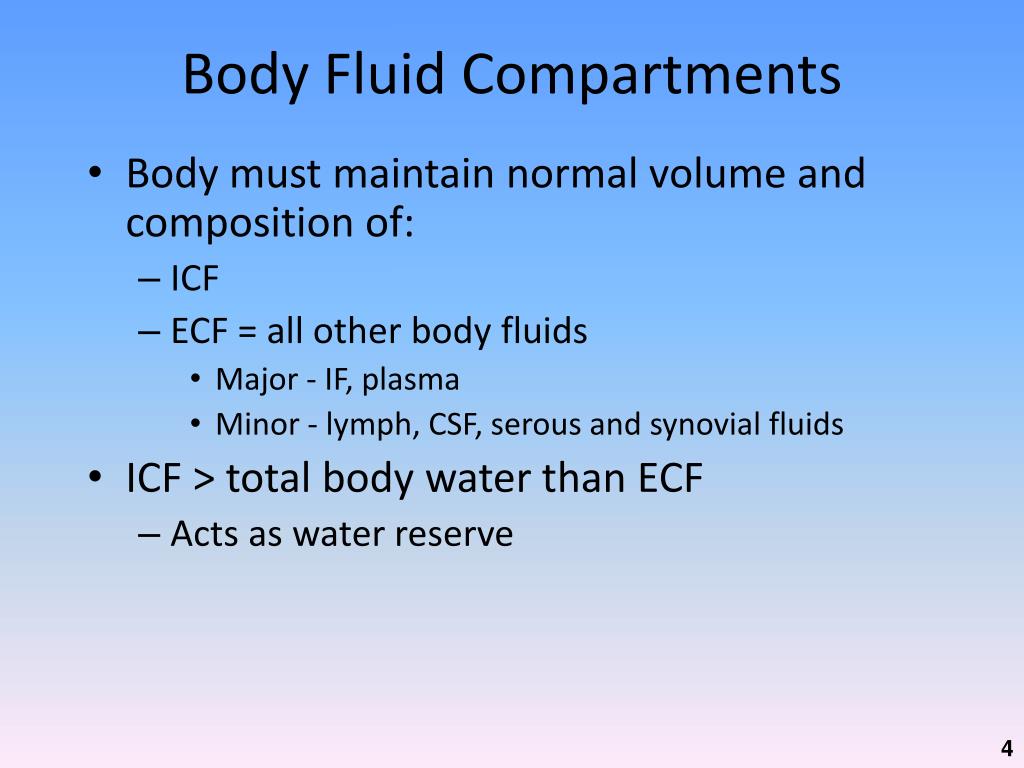

These compartments are best illustrated as a tree: Intracellular fluid compartment. These results and the increased ratio of extracellular to intracellular water volume can be explained by assuming a decreased growth of the intracellular compartment. That fluid is divided into two major compartments, the intracellular compartment, which includes all the water inside the cells, and the extracellular compartment, which includes all the water outside the cells. The ECS is divided into three additional. We conclude that the lower body mass in hypoxemic lambs is mainly related to a lower intracellular water volume. The human body is divided into two main compartments: intracellular space (ICS) and extracellular space (ECS). Intracellular Fluid (ICF): The amount of water thats inside our cells accounts for 2/3rds of our TBW. In the human body, solutes vary in different parts of the body, but may include proteinsincluding those that transport lipids, carbohydrates, and, very importantly, electrolytes. Fluid compartments in the mammalian body broadly comprise two compartments, each with several subdivisions: intracellular fluid (ICF), which makes up approximately 60-65 of body water, and extracellular fluid (ECF), which makes up the other 35-40 of body water (for all practical purposes, the only solvent in the body is water ). The dissolved substances in a solution are called solutes. Blood volume was increased in hypoxemic lambs (121 ± 29 versus 79 ± 15 mL-kg -1, p < 0.01), mainly due to an increased total red cell volume (48 ± 12 versus 22 ± 8 mL-kg -1, / < 0.001). Body Fluids and Fluid Compartments The chemical reactions of life take place in aqueous solutions. The ratio of extracellular to intracellular water volume was higher in hypoxemic lambs (0.69 ± 0.10 versus 0.55 ± 0.04, p < 0.01). Total body water (753 ± 27 versus 780 ± 40 mL-kg -1) and extracellular water volume (307 ± 25 versus 277 ± 15 mL-kg -1) in hypoxemic lambs were not significantly different from those in control lambs, but intracellular water volume was decreased (445 ± 27 versus 501 ± 35 mL-kg -1, p < 0.01). The lower body mass in hypoxemic lambs (10.5 ± 2.3 versus 13.0 ± 2.8 kg) could be mainly accounted for by a decrease in intracellular water volume (4.7 ± 1.3 versus 6.6 ± 1.5 L, p < 0.01). Hypoxemic lambs had a lower arterial oxygen saturation (65 ± 11 versus 91 ± 2%, p < 0.001) and a higher Hb concentration (142 ± 16 versus 101 ± 8 g-L -1, p < 0.001).

What is body osmosis Osmosis is when water moves from an area of LOW solute concentration (low osmolarity) to an area of HIGH solute concentration (high osmolarity) through a semipermeable membrane. For the average 70 kg man, 60 of the total body weight is comprised of water, equaling 42L.

Therefore, fluid compartment volumes were studied in nine lambs, after 3 to 4 wk of experimental cyanotic heart disease, and in 13 control lambs. Fluid movement from the intravascular to interstitial and intracellular compartments occurs in the capillaries. Note that this diagram places focus only on these three major fluid compartments. Plasma is the smallest fluid compartment (8 of total body water). Interstitial fluid contains 25 of the total body water. In this study, we determined to what extent the lower body mass in these lambs was related to alterations in body fluid compartment volumes, specifically whether intracellular volume was decreased. The intracellular fluid compartment contains most of the water in the body (67 of total). In lambs with experimental cyanotic heart disease, the gain in body mass was decreased. This fluid is distributed between blood plasma, interstitial fluid, and intracellular fluid with the following proportions: Body Fluid Compartment: Proportion (%) of Total Body Water (TBW): Blood Plasma 6.6 Interstitial Fluid 33.0 Extracellular Fluid (ECF) 26.4 Intracellular Fluid 67.0 67.ABSTRACT: Chronic hypoxemia is associated with a decreased growth rate and a decreased rate of cell division. For a typical 70 kg person, approximately 42 kg of this weight is water (which is equivalent to a volume of approximately 42 L of water). Welcome to Module 2 of Introductory Human Physiology We begin our study of the human body with an overview of the basic concepts that underlie the functions of. Background Information: Body Fluid Compartments The human body is made up of roughly 60% water with dissolved ions in various body fluid compartments.


 0 kommentar(er)
0 kommentar(er)
